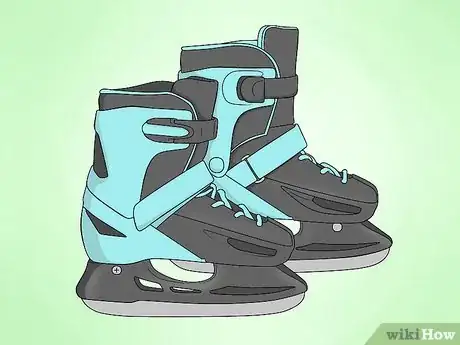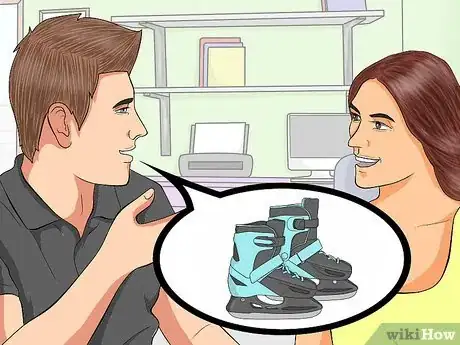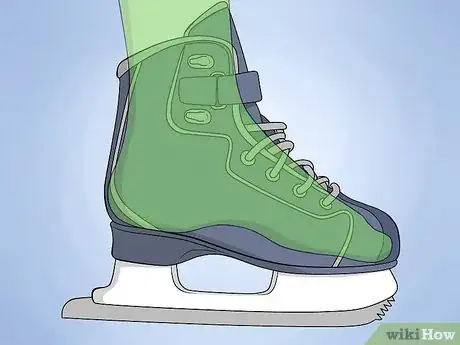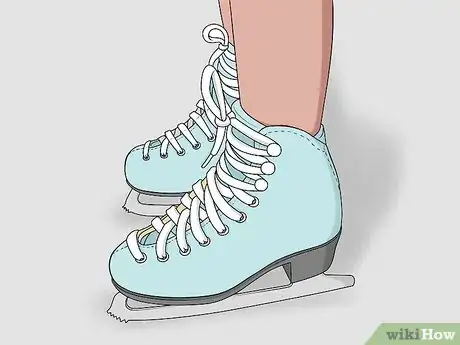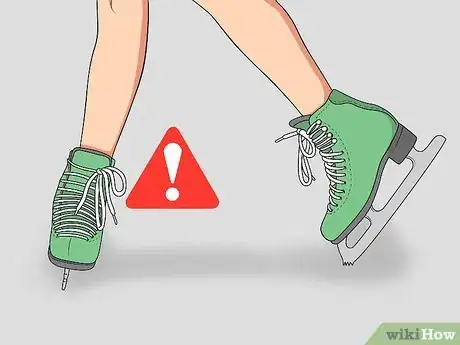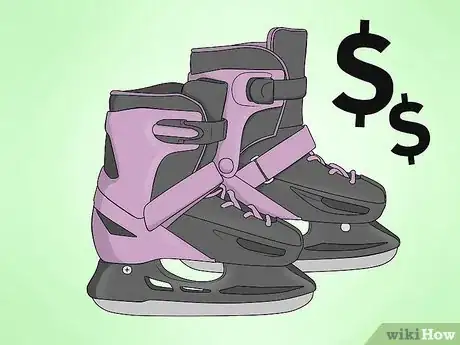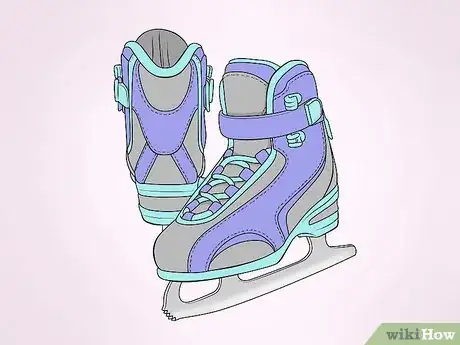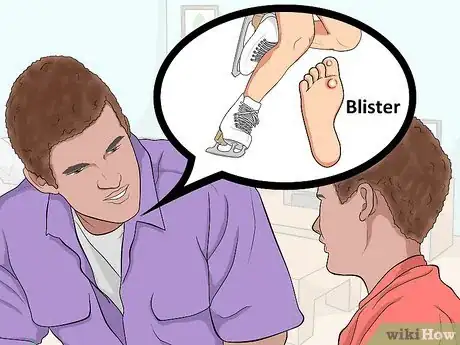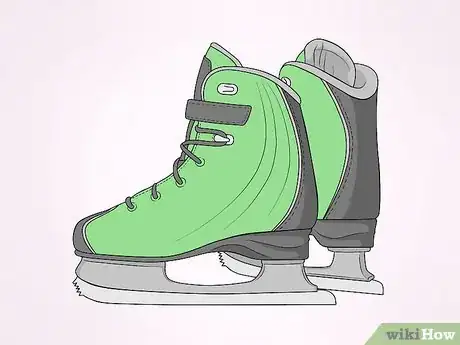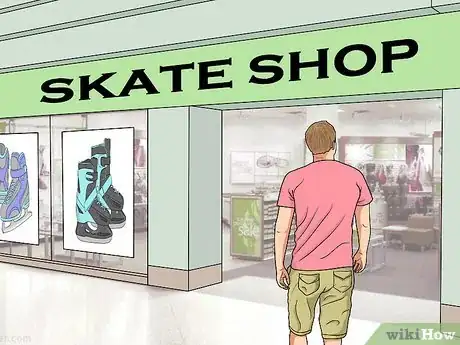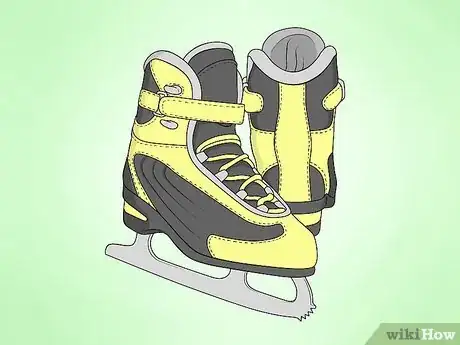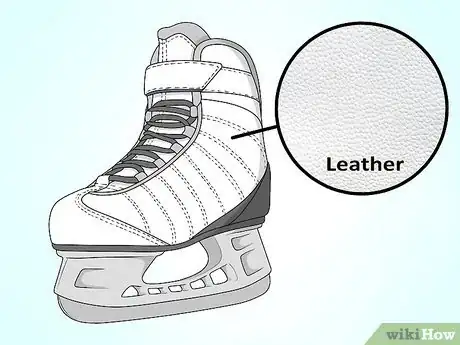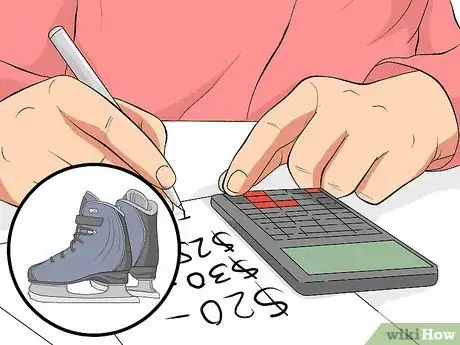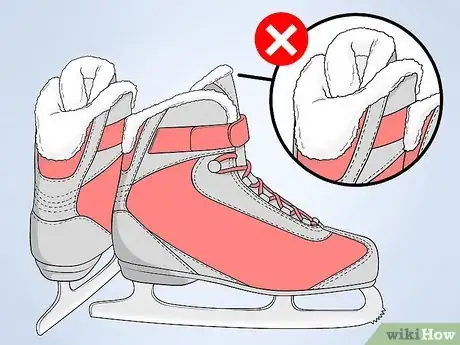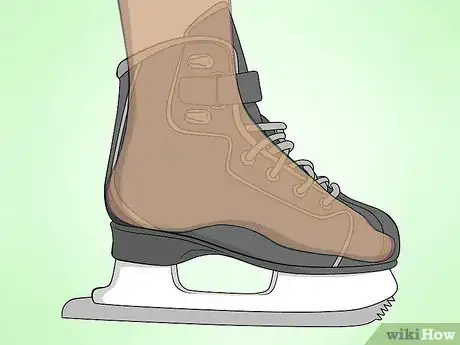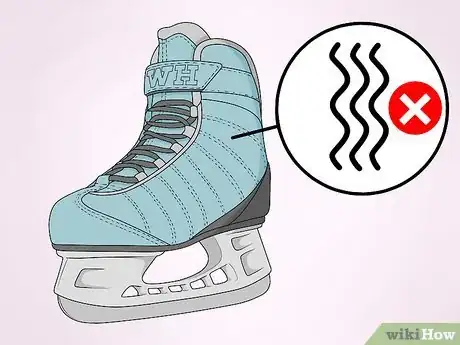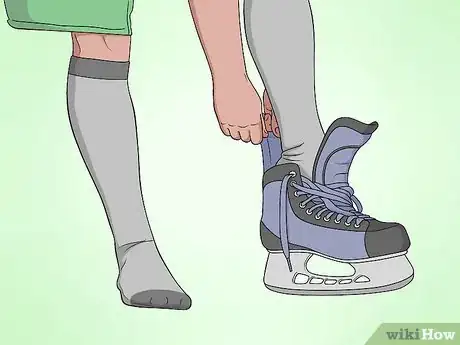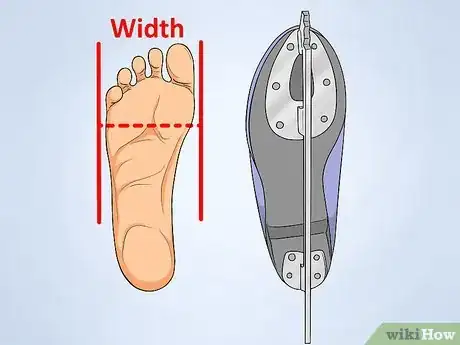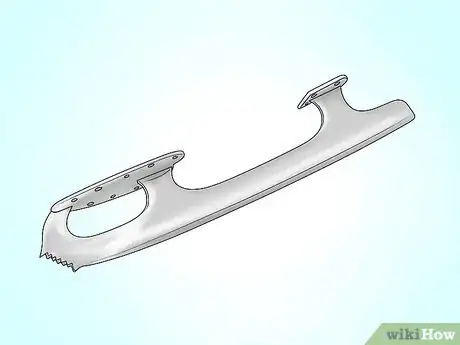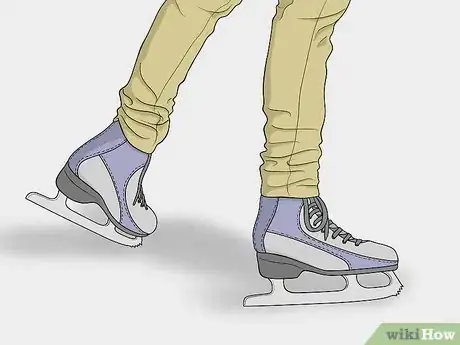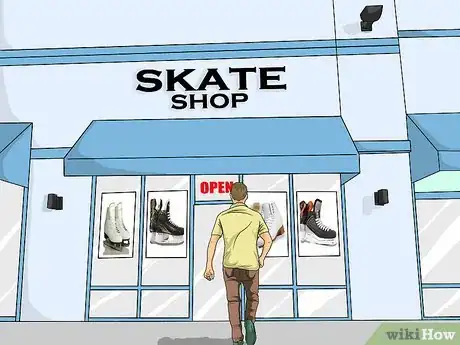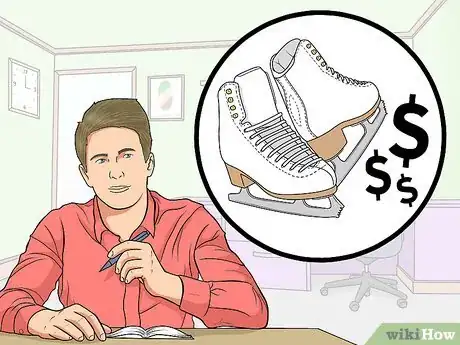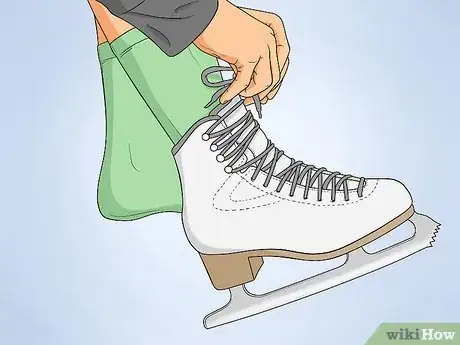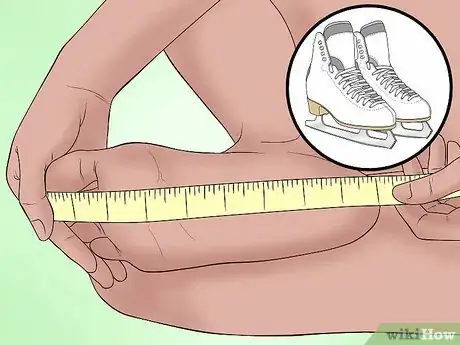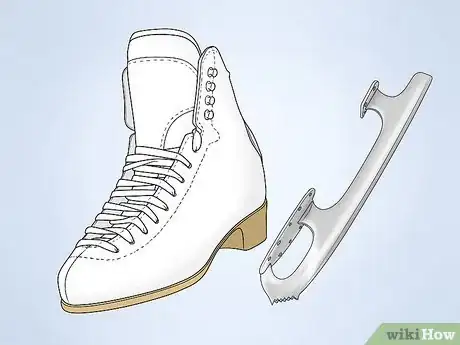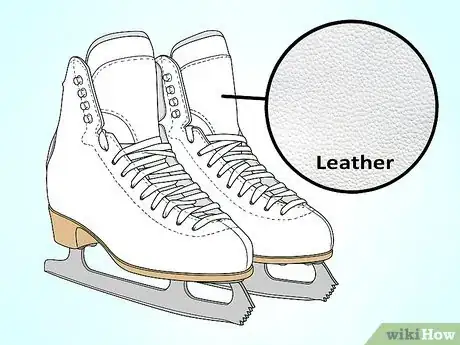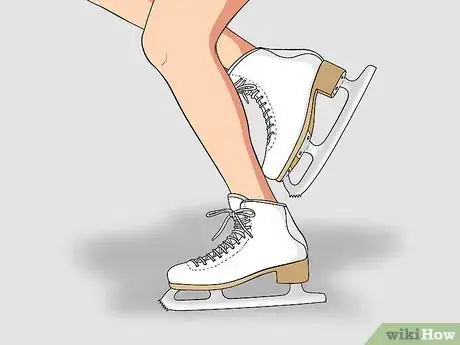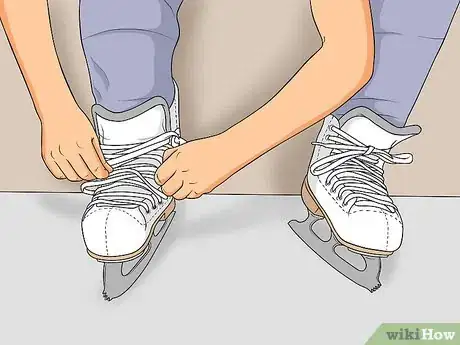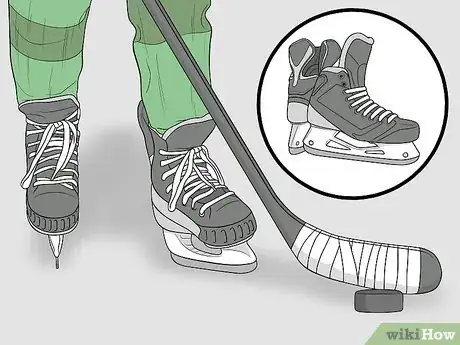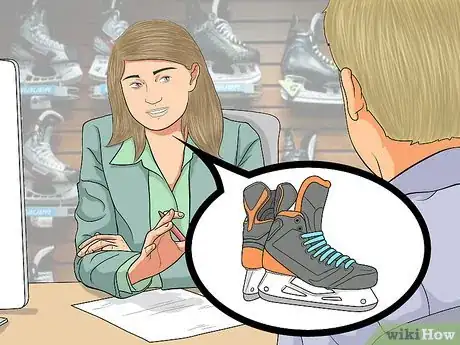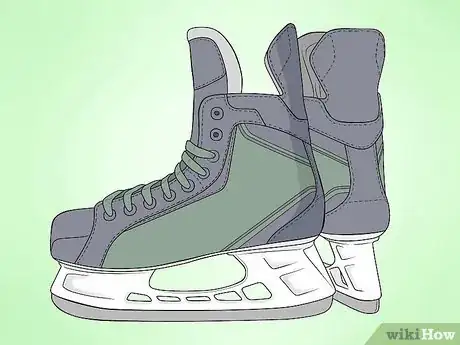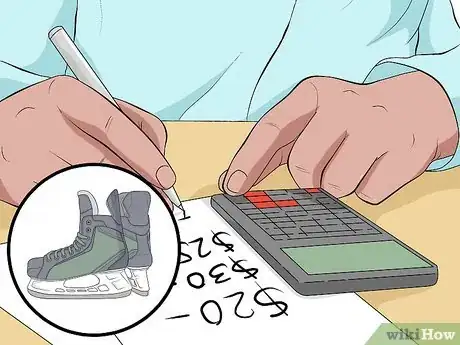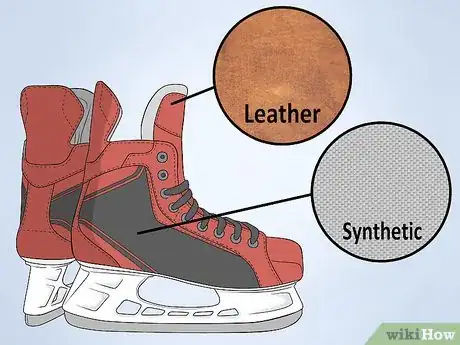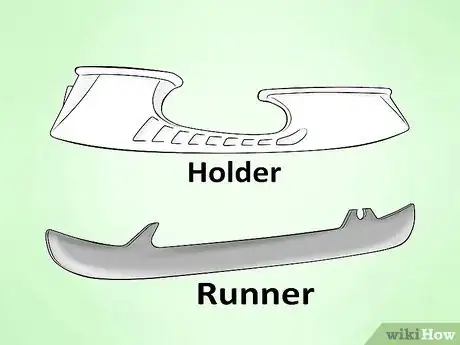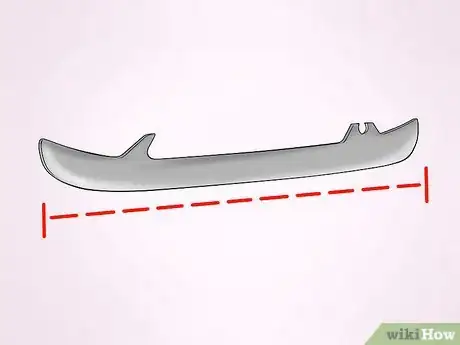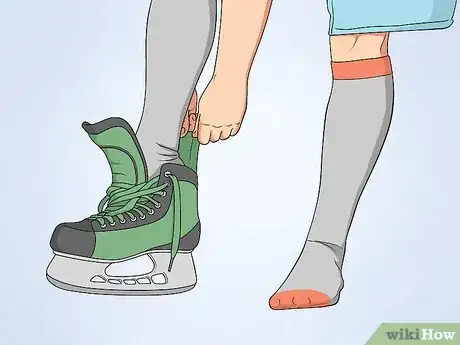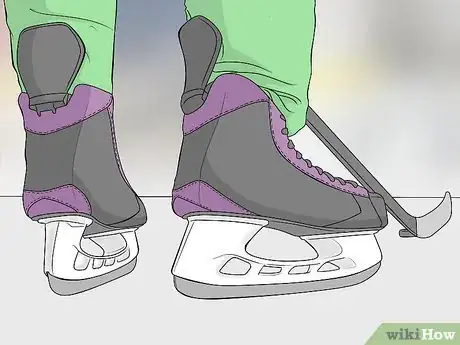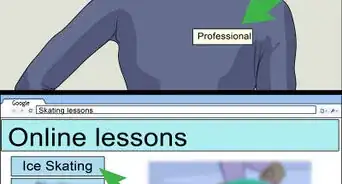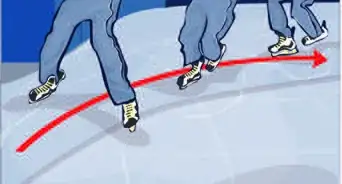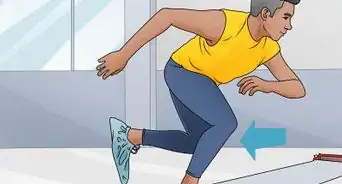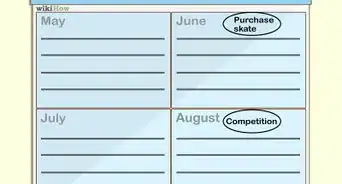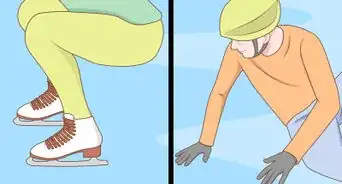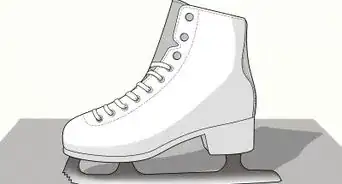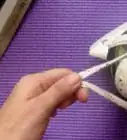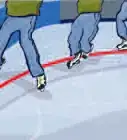X
wikiHow is a “wiki,” similar to Wikipedia, which means that many of our articles are co-written by multiple authors. To create this article, 15 people, some anonymous, worked to edit and improve it over time.
This article has been viewed 48,690 times.
Learn more...
It can be confusing to choose the correct kind of ice skates. Choose skates based on your ability level and the skating you would like to do. Types of skates include kids skates, recreational skates, figure skating skates, hockey skates and speed skating skates. By following a few simple steps, you can choose the perfect skates for your chosen activity and skating type.
Steps
Method 1
Method 1 of 4:
Buying Ice Skates for Kids
-
1Look for skates that are specific to your child's needs. Hockey skates won't work for figure skating, and figure skates won't work for playing hockey.
- Figure skates have a longer blade and a toe pick on the front, while hockey skates have a curved blade and no pick.
- Figure skates are more stable than hockey skates and are better for recreational skaters. If you are purchasing a first pair of recreational skates for your child, you're probably better off starting with figure skates.
-
2Take your child's age into account. Most of the guidelines for purchasing children's ice skates apply to children of all ages, but keep in mind that:
- Toddlers need skates with a wide double rail (two blades) and a solid bottom. These skates will be safer and more comfortable for very young skaters, and they won't need to be broken in.
- Children younger than six should also have a double rail to prevent wobbly ankles.
Advertisement -
3Get professional advice. There are a huge variety of children's ice skates on the market, and different types of skating call for different skates. In general, then, it's best to buy your child's skates from a dedicated skating store, where you can get the advice and assistance of a professional.
- Avoid purchasing skates from a general department store. Without professional guidance, you may wind up with the wrong type of skates for your child, and this could lead to poor performance, an uncomfortable fit, or even an injury.
- If your child has a coach or teacher, you can also use this person as a resource! He or she will have specific recommendations for your child and may also know where you can get the best deal on the skates you need.
-
4Get the right size. Correct fit is crucial -- if the skates are too small, they will hurt your child's feet, but if they are too large, they won't provide the necessary stability. Your child will likely need a different size in skates than he or she wears in sneakers, so again, a professional fitting is important.
- Take your child to try the skates on, wearing thin socks (or whatever socks he or she will usually wear when skating). Try on several different brands, as each will have a slightly different fit. The skates should feel quite snug compared to regular shoes, but they should not be painful.
- Lace up the skates completely when trying on. To get the best sense of the way a particular pair of skates will fit, you need to lace them all the way up.
- Have your child stand and walk in the skates. If his or her heel lifts out of the boot, or if there is much wiggle room in the toes, the skates are too large.
- You may be tempted to buy a larger size so that your growing child can wear them for a bit longer, but this isn't a good idea -- in fact, it could even lead to injury.
- If you absolutely cannot try on skates in person and must estimate, start with a pair of skates two sizes smaller than your child's typical sneaker size.
-
5Buy skates that are comfortable. If you've found the right kind of skates in the correct size, you're already well on your way to choosing something your child will feel comfortable in. However, there are a few other things to keep in mind when you compare options:
- Avoid buying double-bladed skates, or the kind that you strap onto your shoes. These skates don’t grip the ice properly. Your child may feel wobbly and uncomfortable in these skates, and he or she may wind up with a completely avoidable injury.
-
6Pay attention to ankle stability. Children’s skates should provide good ankle stability to prevent injury. This means that the skates need to have moderate stiffness, and your child should not be wobbly while standing in them.
-
7Choose quality skates. Although they are more expensive, higher quality skates will provide comfort and stability, leading to happy and injury-free skating sessions. In general, good figure skates will be made out of leather; while good hockey-style skates will be made out of strong but lightweight materials.
- Different brands work best for different skates, but in general, Jackson and Riedell are seen as the best figure skate manufacturers. Bauer is a popular brand for hockey skates.
-
8Look for affordable skates. Kids can outgrow skates very quickly. Since you can't buy skates a size too large without risking injury, you'll want to look for something affordable. It's probably not wise to buy the cheapest skates on the market, as these might not provide the support, comfort, or performance that you want, but there are a few ways to save money on your child's skates:
- Consider a skate package. While boots (the shoe part) and blades can be bought separately, it is often easier and cheaper to purchase them as a package. This is especially true for kids, who may only be using their skates for one season before outgrowing them.
- Look for skates allow for size adjustments. Some skates are built to be adjustable so that children can use them for a longer period of time.
- Consider used skates. If you are struggling to afford a quality pair of skates for your child, you can try getting used ones from friends, relatives, or your children's teammates. However, fit and function are still crucial. If you can't find the right kind of skates in a good fit, it's not worth the savings.
-
9Buy skates that allow for easy maintenance. Skates that have the boots and blades attached allow for easy maintenance. Additionally, you will want blades that maintain their sharpness to reduce the maintenance required. Quality blades will reduce the need for constant sharpening.
- Make sure you use blade guards and completely dry your skates every time you use them to maintain them.
-
10Explain to your child that new skates must be broken in. Brand new ice skates might feel slightly uncomfortable, even if they fit perfectly. Your child may wind up with a blister or two. Make sure your child understands that these issues should be temporary; once the skates have been worn a few times, they should feel nice and comfortable.
- You can minimize this period of discomfort by having your child wear brand new skates for only thirty minutes at a time.
Advertisement
Method 2
Method 2 of 4:
Buying Recreational Skates
-
1Choose recreational skates if you are a beginner, do not skate often, and do not do jumps or spins. Recreational skates are very different than those for figure skating or professional skaters. They are made to allow you to move forwards and backwards, do crossovers, and complete simple turns, but they won't work for competitive figure skating or professional-level hockey.
-
2Purchase skates from a dedicated skating store. In most cases, it's best to buy from someone trained to recommend the best skates for your needs. Do not purchase skates from a general department store because these skates will not give enough ankle support and can increase your odds of winding up with an injury.
-
3Choose skate packages. For most recreational skaters, skates that have the blade and boot (the shoe part) already connected work best. These skate packages are often cheaper, lower maintenance, and simpler to purchase.
- Most recreational skates come with the blades already attached to the boots. Check with a professional at the skate shop to see what your options are.
-
4Focus on quality. The best recreational figure skates should be made of leather, with steel blades attached only to the sole of the skate. Recreational hockey skates should be made at least partly from cloth and have a fiberglass frame.
- Cheaper recreational skates will often be made out of plastic or synthetic leather. If you don't skate often and don't feel you need the highest quality skates, this may be an acceptable compromise for you.
- Skates made out of vinyl will be very cold. They do not provide much stability, either, so it's best to avoid them.
- The best hockey skates will have a gel layer inside that conforms to your feet when they warm up.
-
5Consider your budget. Recreational skates start around $50 and can go up in price from there; some are as much as $1000. Most recreational skaters should budget somewhere between $50-$200, depending on the desired quality. Skates at the low end of the range will be of lower quality and comfort than those at the upper range.
- If you buy boots and blades separately for figure skating, you'll spend more -- perhaps up to $600 for the boots and $600 for the blades.
-
6Avoid fleece-lined skates unless you are using them for outdoor skating. Fleece-lined skates have limited usefulness unless you are skating outdoors in very cold weather. Otherwise they do not provide much control over your feet and can be difficult to use.
-
7Choose the correct size. Start by trying on skates that are one size smaller than your normal shoe size -- skates are meant to be tighter on your feet than normal shoes.
- It may be difficult to find special sizes in recreational skates but they can come in many sizes and different widths. Check with your skating store to see whether they carry skates in very small or very large sizes, and see which brands come in narrow or wide versions.
-
8Choose boots with the right stiffness. Many recreational skates are quite soft for extra comfort but not good for intermediate figure skaters that will be doing turns and spins. Skates with a moderate stiffness will be best for providing good support while also being flexible enough for quick breaking in and good comfort.
- If you are a beginner or just want to enjoy being on the ice with family and friends then you should choose a soft skate for comfort.
- If you are an intermediate skater and beginning to learn freestyle skills but are not ready to be high-end figure skating skates then you should go with a more moderately stiff skate.
-
9Look at the tongue of the skate. Check the tongue of the boot for stiffness and padding. The tongue has a big effect on comfort and extra padding will protect your legs and feet from injury.
-
10Try on the skates properly. Wear thin socks that are the same as those you will be skating in, and lace your skates properly. Skates should be laced loosely around the toe area, tightly over the bridge of your foot and beginning of your ankle and a bit looser around the top of the skate.
- Thin socks give better control over the skate and should not make your feet cold if you choose good-quality skates.
- Do not wrap long laces around your ankle; rather loop them around the hooks at the top of the skate.
-
11Test the skates. Walk around for at least five minutes to test the skate and see how it feels. Your heel should not be moving around at all. If it does move try to tighten the skate and if it still moves, then you should go down to the next size.
- Walking wobbly or standing knock-kneed or pigeon-toed is a sign that you may need a smaller size skate.
- If your skates are painful to walk in or if your feet fall asleep within five minutes of walking then you should try a half size bigger.
- You should feel as solid walking in skates as you do in your normal shoes. When you bend your knees your skates should give slightly without your ankles rolling.
-
12Check the width of the skate. Skates can come in different widths and they can be stretched to some degree. If your skate seems a little tight across the ball of your foot then you might be able to fix the problem with a spray or stretcher.
-
13Keep your blades sharp. Ice skate blades should have two edges with a slight hollow in between and should be smooth and without dents. They should also easily scratch the surface of your fingernail when you run it across. If you see any of these problems then you should have your skates sharpened.
- Some stores will be able to sharpen the skates for you. Alternatively, most indoor rinks or skating supply stores will have a specialist who can sharpen your blades for you.
-
14Understand that your skates will take some time to break in. Even if you choose skates that are sized perfectly, they may cause some discomfort or blistering the first few times you wear them.
Advertisement
Method 3
Method 3 of 4:
Buying Figure Skating Skates
-
1Choose figure skates if you are an intermediate to advanced-level figure skater. Figure skates provide specialized support and control for advanced skaters. This allows skaters to execute jumps, spins and difficult turns. These skates will be very different from those for recreational skaters.
-
2Purchase skates through your coach or from a dedicated skating store. Figure skaters need professional advice in selecting skates, so don't shop from regular department stores. Having the right pair of skates is much too important to risk buying from anyone who isn't trained to help competitive skaters.
-
3Determine your budget. High quality figure skating boots can cost $600, with the blades costing around the same. Speak to your local store or coach to determine the amount you will need to budget for your skates.
- If your budget is tight, it may be better to purchase higher quality used skates as opposed to lower quality new skates. Make sure the used skates fit correctly, have sufficient support, and have blades that still have some “sharpening life” left. When in doubt, consult with your coach or another professional before buying.
-
4Know that finding the right skates can take time. Figure skates can be quite expensive, so it is important to choose the correct ones for your size and ability. Don't assume that the first pair you try will work; you may need to try several different sizes in several different brands before you find something that works.
-
5Choose the correct size. There should be no extra room in the boot. Figure skates are meant to fit quite tightly to increase stability while skating. In fact, many figure skates can be heat molded to fit your feet exactly. Take advantage of this opportunity -- "baking" will mold the skates to your feet as perfectly as possible.
- Measure both your feet when deciding on your shoe size in case one foot is bigger than the other.
- Sizing differs between brands, so be aware that if you choose a new brand, you may also need to choose a new size.
- Choose the correct width. Many figure skates come in narrow or wide sizes, so don't settle for a mediocre fit.
-
6Buy your boots and blades separately. While pre-assembled packages are fine for beginners and recreational skaters, it is better for intermediate and advanced skaters to choose their boots and blades separately. This allows you to customize your features according to your body and style.
- Again, consulting a professional is crucial. Your coach or another professional can help make sure you get the right combination of boots and blades.
-
7Select higher quality boots according to your level. Competitive boots are typically made of leather and come in different levels of support. Boots for those completing single jumps will be lightweight while those for doubles and triples will be stiffer to provide a better level of support and stability.
- Stronger, heavier skaters should choose boots that offer additional support.
-
8Choose higher quality blades. Higher quality blades will be sharpened less often and have better flow on the ice. Blade quality will affect spin and jump quality so it is an important aspect of your skates. Blades are usually chosen based on the size and features of the toe pick.
- Larger toe picks give more stability for jumps.
- Smaller toe picks and shorter blades are better for dance and synchronized skating.
- Parabolic blades are good for those having trouble with edge slips.
- K-picks are for those who skid or slip or toe jumps.
-
9Customize your skates as needed. Advanced figure skaters may need to make minor adjustments to their skates for the perfect fit. If you find the right pair of skates, and they fit well in general but rub your feet uncomfortably in just one or two places, you can have them "punched" (pushed out a bit in particular spots).
-
10Lace your skates properly every time you wear them. Properly secured laces are essential for providing stability and comfort while skating.
- Make sure your foot is placed in the boot all the way and tighten up the laces in the first half of the boot. The laces in this section should be secure but not overly tight.
- Lace the second half of the boot and pull hard over the top of the foot and where the ankle bends. This area is the most the important part of lacing figure skates.
- Finish lacing the boots around the hooks without pulling the laces too hard. The laces should be secure but not overly tight.
Advertisement
Method 4
Method 4 of 4:
Buying Hockey Skates
-
1Choose hockey skates if you are playing ice hockey. Ice hockey is a competitive sport that involves a lot of time in your skates. Different positions will require different kinds of skates, so it important to know what style of play you will be engaging in.
-
2Get professional advice. Purchase skates from a dedicated skating store so that you can get the advice and assistance of someone who knows about hockey skates. Do not purchase skates from a general department store; these skates will not provide enough ankle support and may make you more prone to injuries.
-
3Purchase the correct type of hockey skates. There's more than one kind of hockey skate on the market, and they are truly distinct, so it's important to buy the correct kind.
- Goalie skates have a lower boot with a wider blade for more stability and ankle and foot protection.
- Other kinds of hockey skates also differ according to certain features, including blade radius. Your individual needs will depend on what position you play.
-
4Determine your budget. Hockey skates start at about $50 and go up from there, depending on the quality of the materials used to make the skates. If you play competitively, you may want to invest in a more expensive pair of skates.
-
5Decide on the material for the boots of your skates. Most hockey skates are a mixture of leather and synthetic materials to optimize durability, performance and comfort. Different synthetic materials such as Kevlar or graphite will determine the quality of the skate and the cost. Talk to your coach or another professional about the best material for your needs.
- You want hockey skates with the highest durability, comfort, ankle support, stiffness, padding and workmanship in the most lightweight skate possible.
- Many hockey skates offer gel inside that can warm up and mold to your feet, providing the best comfort and fit.[1]
-
6Choose either a one-piece or two-piece holder and runner. On hockey skates the holder is the plastic piece between the boot and runner and the runner is the blade. Most beginning-level hockey skates will have a one-piece holder and runner.
- It is better to choose a one-piece holder and runner for a beginner hockey player because they are cheaper. If the blade or holder happens to break at some point it usually costs around the same to replace the entire skate.
- Competitive hockey players will want to choose the two-piece design because if the runner breaks it can be easily replaced. The runner and/or holder may break when a high-speed shot is taken directly at the runner/holder.
-
7Choose the correct blade length. Hockey blades have a concave, or hollowed out, shape and are measured based on the amount of blade that is in contact with the ice, called the blade radius. To measure radius place the two blades together, bottom-to-bottom, and measure the distance between the points where the blades touch.
- Beginners will want a blade radius of around 5 inches (12.5 cm) to give stability while moving forward and backwards.
- To improve cutting and turning, choose a blade radius of 3-4 inches (7.5-10 cm).
- If you are a forward you will want a shorter blade radius to improve maneuverability.
- Defensemen will want a longer blade for added stability.
- Goalies will chose an even longer blade radius and have a less hollow grind to increase the contact with the ice.
-
8Choose the correct size. Choose hockey skate size differently from figure skates because they need to be tighter for more stability and less chafing. Try your hockey skates on with a thicker hockey sock, so that you know how they will fit when you are actually playing.
- Different manufacturers make their hockey skates differently, so it is important to try on a range of brands.
- Choose the correct width. Width is one of the most important factors in choosing the hockey skates that fit best. Most brands come in a range of widths including standard width (D or R), wide boots (E, EE or W), and sometimes even narrow width (C). If you have never had issues with sneaker sizes, then you will probably be fine with standard width skates.
-
9Choose comfortable skates. Hockey is a fast-paced game, and hockey players must feel like their skates are part of their feet. It is important to choose hockey skates that are comfortable and feel natural on your feet.
- Understand that it may take some time to break your skates in. The first few times you wear a new pair of hockey skates, you might have some discomfort, or even develop a blister or two. If you've purchased good skates that fit correctly, however, this should be a temporary issue.
Advertisement
Community Q&A
-
QuestionIs it better to buy very cheap ice skates or just keep using rental ice skates?
 BlueTomcatCommunity AnswerIt is better to buy your own skates because you can get used to their fit and this will help you to skate better. Rental skates are not regularly sharpened and can be a bit wiggly.
BlueTomcatCommunity AnswerIt is better to buy your own skates because you can get used to their fit and this will help you to skate better. Rental skates are not regularly sharpened and can be a bit wiggly.
Advertisement
References
About This Article
Advertisement
